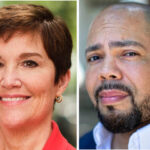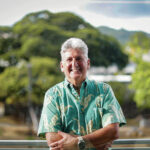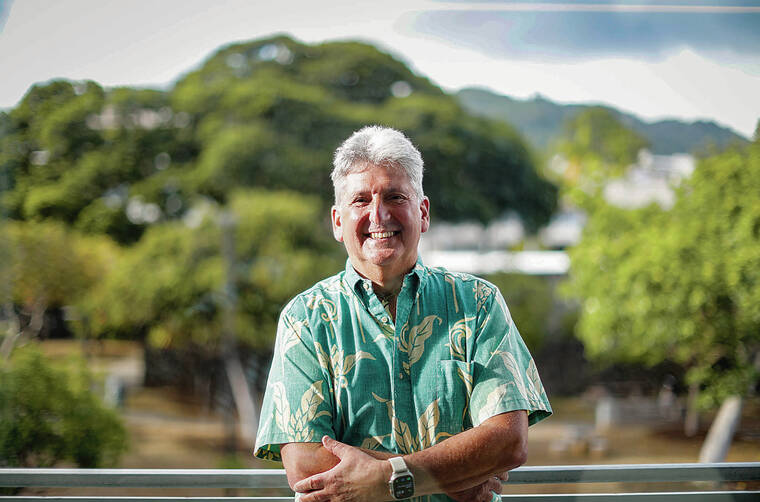David Lassner advises next UH president to work on building relationships


At the end of 2024, David Lassner will close out a 47-year career at the University of Hawaii, including the last nearly 11 years as UH’s 15th president — a job he never wanted nor sought.
Lassner, who just turned 70, has led a 10-campus system that touches Hawaii and its residents in ways unlike any other state department or agency, and he has exceeded the average career life span of typical university presidents across the country.
ADVERTISING
Along the way, he’s won praise for a methodical, low-key approach while guiding UH and helping the state navigate through the unprecedented COVID-19 pandemic, a campus flood, angry protests over the proposed Thirty Meter Telescope atop the summit of Mauna Kea, the condemnation of Aloha Stadium and the subsequent conversion of the football team’s practice field into its new home field.
Following the tragic Aug. 8, 2023, Maui wildfires, UH began offering two- and four-year scholarships to UH campuses to every Lahainaluna High School senior.
At the same time, fundraising and philanthropy efforts have resulted in record donations while enrollment soared to a record at the start of this year’s fall semester, especially for Filipino and Native Hawaiian students.
“I didn’t apply for the job,” Lassner told the Honolulu Star-Advertiser in his second-floor office atop UH’s Bachman Hall. “I was supposed to be on a one-year contract. … Six months into the search (for a permanent replacement), they picked me. They said I didn’t need to apply.”
Lassner’s initial stint as a temporary, “interim” president in 2013 followed the doomed presidency of M.R.C. Greenwood, whose watch included the notorious 2012 “Wonder Blunder” debacle over a bogus Stevie Wonder concert advertised to benefit the UH athletic department.
Wonder fans bought an estimated 6,000 tickets that had to be refunded.
UH officials later told the state Senate Special Committee on Accountability, which investigated the fake concert, that they paid $200,000 to a Florida company claiming to be authorized to book Wonder, only to find out that Wonder’s representatives had not approved the concert nor received any payment. Greenwood told state senators that UH was the victim of fraud.
The state Senate committee estimated the cost at over $1.3 million.
Lassner also inherited a UH system that was under investigation by the U.S. Department of Education for Title IX violations.
“It was a period of pretty high drama,” Lassner said. “If UH was on the front page, it was probably not good for UH.”
Following Greenwood and her controversial predecessor, Evan Dobelle, Lassner said the UH Board of Regents “wanted somebody that was pretty connected to this place. M.R.C. never figured this place out.”
A series of Title IX reforms began under Lassner, including uniform policies and training across all 10 campuses. Changes now also include a ban on “consensual relationships” between employees and UH students who are in direct contact or under supervision.
UH now calls itself “a national leader when it comes to Title IX compliance.”
Lassner said, “people appreciated the calm.”
Calm, steady leader
As a student at Castle High School in Kaneohe, now-U.S. Rep. Jill Tokuda learned later that a technology innovation she and other high school student leaders used in the 1990s to communicate with one another across the islands had been spearheaded by Lassner while he was a UH information technology leader, long before he became UH’s president.
Tokuda said, “We distributed 500 ‘video tex’ machines that were boxes with screens and keyboards. We took it as students to communicate with one another statewide as part of state student council. We would send out a chat with (then-Gov.) Ben Cayetano’s number to call and say, ‘We need more funding for public education so anybody could access high-quality meaningful education, no matter where they lived in the state.’ I only found out later that the guy behind it all was Lassner. Lassner’s heart has always been in the right place.”
After Lassner filled in as interim UH president in 2013 while UH regents continued their search for a permanent president, Tokuda thought that Lassner “would go back to his computers. Sometimes the best person for the job is the person that doesn’t want the job. It enabled him to be bold. His leadership style, his approach, was one of lifting people up.
“It was about the good of the institution, especially coming off some colorful, controversial presidents,” Tokuda said. “Lassner was the kind of leader we needed for that moment and many moments after.”
For the next UH president, Tokuda said, “That’s a big weight and responsibility. They have really big shoes to fill. You are stepping into a role following somebody who spent almost half a century working for the institution and a decade as its leader. It will be very difficult following Lassner after he brought this institution to its high point. I hope they come to this position with great humility and with a desire to learn and engage with our community and our culture and our people.”
The next president
The UH Board of Regents has narrowed its search for Lassner’s successor to two finalists: Wendy F. Hensel, executive vice chancellor and university provost for The City University of New York, and Julian Vasquez Heilig, provost and vice president of academic affairs for Western Michigan University.
Either Hensel or Heilig is expected to be named in October, said former Gov. Neil Abercrombie, who now serves as a UH regent.
Both candidates are scheduled to begin meeting with the community and students, staff and faculty — both virtually and in person — on UH campuses beginning today on Maui for Hensel and starting Sept. 30 on Maui for Heilig.
Whoever becomes the next UH president will be a malihini inheriting a system that remains Hawaii’s third economic driver, behind tourism and the military, and will have to learn how important the UH system is to people across the state, Abercrombie said.
The UH system affects all walks of life in Hawaii, whether through sports, training in the trades at the community colleges, as an economic force or by educating generations of residents who have gone on to institutions, agencies and businesses across the islands, Abercrombie said.
As a state legislator, Abercrombie also chaired House and Senate education committees and said the next UH president must be “smart enough to understand that they’re going to be viewed suspiciously by some people because they’re not from here.”
But Hensel and Heilig became the finalists, in part, because of the results of a community survey of what people want from the next UH president, he said.
Being from Hawaii — or from within the UH system — was not a priority among the top results from “a deep reservoir of commentary coming from the public,” Abercrombie said.
“They said we needed to become much more of an international university in the Pacific,” Abercrombie said. “There was a desire for a top qualified person, not necessarily a local person. They wanted a president with a deep, broad vision for the university.
“I and the rest of the regents agree these two people were at the top of the list,” Abercrombie said.
After being named Lassner’s successor, Hensel or Heilig will have a little more than two months to work with Lassner on the transition before the end of the year — and the start of the next legislative session — before Lassner steps down and goes on safari with his brother to Botswana.
It will be his “first vacation without a laptop,” Lassner said.
He plans to follow up with trips to Antarctica, Turkey, Machu Pichu, Patagonia, Iceland and Bali — “all places I want to go. It’ll be pure fun.”
In between his travels, Lassner will remain on campus with an office in the information technology building and the title of president emeritus.
Lassner has not met with the two finalists hoping to replace him. But his advice: “There are lots of groups to reach out to and understand. You’re going to have to figure out which are the most important to spend time on. It is imperative. This is a relationship-based place.”
Being president of the UH system means the spotlight is never far away. Lassner made headlines when the car he was driving early in the morning on Jan. 1 overturned in a non-injury, one-vehicle crash in which first responders found no evidence that alcohol was involved.
And when UH gets in the middle of controversy, such as protests over the proposed Thirty Meter Telescope atop the summit of Maunakea, the arguments both for and against became “painful” to Lassner.
“I understood civil disobedience,” Lassner said. “I was raised by people who protested the war in Vietnam.”
He called the “energy” of the TMT demonstrations “powerful. Many of those leaders, most of the young ones, were educated directly or indirectly by a UH campus.”
A group of demonstrators marched to Lassner’s home in Palolo and he received death threats. (Lassner does not live in the UH president’s mansion, College Hill, which is now used for UH events).
Demonstrations about Maunakea were “super hard for me personally,” Lassner said. “I had friends and colleagues on both sides of it. People were hurting so much. Whatever you believed in was questioned by the other side.”
Outwardly, Lassner takes a calm, low-key approach that — some of his vice presidents say — gives them room to come up with solutions without being micromanaged by Lassner.
Vassilis L. Syrmos, UH vice president for research and innovation, has known Lassner for 30 years, starting when Lassner was the IT director and Syrmos was teaching electrical engineering.
“David always was — and still is — well prepared,” Syrmos said. “He had a deep understanding of every subject he decided to look into and David has an unbelievable memory. He can cite things from 30 years ago. He’s not bombastic. He’s humble, not flamboyant, but he cares and it shows in everything he does every day. He’s always the steady hand that figures out the problem, figures out the process and executes it. We will miss him.”






